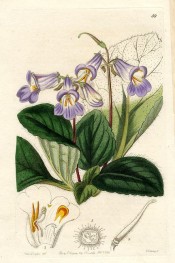Chirita sinensis Lindl.
Frost-tender evergreen perennial with flat rosettes of hairy, dark green leaves, sometimes veined with silver, and occasional white, flowers suffused with pinkish purple to mauve. To 5cm. [RHSE].
Horticultural & Botanical History
Introduced to Britain in 1843 by Robert Fortune. ‘Each flower is tube-formed, an inch long, with open mouth divided into 5-lobes, and the colours purple veined with red, rose and white.’ [FC p.52/1847]. ‘This charming little greenish plant is one of the first results of any importance from the voyage to China by Mr. Fortune, on account of the Horticultural Society. It was sent home in a wooden case, and its beautiful large lilac fox-glove-like flowers were open when it arrived. We were accidentally unable to describe the flowers, for whose structure we are therefore obliged to trust to our artist, who we hope has been correct in the drawing. From this it appears that the plant belongs to the genus Chirita, distinguished from Didymocarpus by its stigma, having the upper lip abortive, and the lower two-lobed. Those who see what this is may judge how desirable it would be to obtain from India the other species of the genus, among which are some still finer. And they are all so easily cultivated, that they are just the things to introduce into gardens. Anybody who can grow a Gloxinia can manage a Chirita. It appears to be a stove plant, requiring to be potted in a compost of peat loam and sand, in equal proportions. During the summer season an ample supply of water should be given to its roots, taking care to wet the leaves as seldom as possible. In winter, water once a week will be quite sufficient. It may be propagated from leaves, cut at the base of the veins, and laid down on a pot filled with silver sand.’ [BR f.59/1844]. MB p.243/1847. FS p.58/1845.
History at Camden Park
Listed in the 1850 and 1857 catalogues [B.67/1850]. Obtained from James Backhouse. It was included among desiderata in a letter dated 10th April 1846, and recorded as arrived [MP A2933-1 p.136]. It was also requested from Kew in 1848 and recorded as arrived and marked with a ‘c’ which in other documents means ‘grown at Camden’. [MP A2933-1 p.165]. It was also requested from John Lindley of the London Horticultural Society on 15th Feb. 1848 [MP A2933-1 p.157]. It is not recorded as ‘arrived’ in Macarthur’s copy but was marked with a ‘c’. It was also requested of Loddiges’ Nursery on 13th February, 1848 [MP A2933-172] and in a letter to Loddiges’ dated 1st February 1849 Macarthur comments that Chirita sinensis is in bloom, suggesting that it was also obtained from this source [MP A2933-1 p.185].
Notes
Published Feb 01, 2009 - 01:18 PM | Last updated Jul 21, 2010 - 03:27 PM
| Family | Gesneriaceae |
|---|---|
| Category | |
| Region of origin | Himalayas and China |
| Synonyms | |
| Common Name | |
| Name in the Camden Park Record | Chirita sinensis |
| Confidence level | high |
